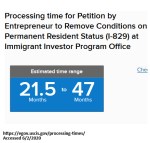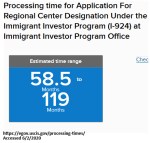Interpreting Processing Times Reports
June 2, 2020 6 Comments
And now, to demystify the USCIS Check Case Processing Times page, which as of today gives these processing times reports for EB-5 forms.
I’ve written a guest article for LCR Capital on Interpreting the USCIS processing times report. The article examines the disconnect between the content and application of the report, and goes in-depth on the following questions:
- Does the USCIS Check Case Processing Times Page reflect the way that USCIS currently processes petitions?
- Does the “estimated time range” on the Check Case Processing Times Page refer to the age of petitions that USCIS is processing now?
- Does the “receipt date for case inquiry” define the limit between normal processing and unreasonable delay?
- Why does the “receipt date for case inquiry” move so erratically, and sometimes retrogress?
- Why are the “historical average” processing times reported by USCIS so different from the reported “estimated time range” for processing?
- How can I estimate the processing time for my petition?
I wrote the article to give clarity and well-researched ammunition to people who may be discouraged and blocked by the USCIS processing times report, but should not be. My article addresses this core conflict:
- USCIS uses the processing times report to create expectations about “normal processing,” and to shut down inquiries.
- If you look at what the reported times represent, they in fact define abnormal and delayed processing.
For example, 29.5 months for I-526 indicates, specifically, that 50% of I-526 recently processed had been pending less than 29.5 months. So if my I-526 has been pending for 30 months, the report tells me that I’m being left behind – that over half of recent decisions were on cases younger than mine. And yet some people – including IPO, if I inquire – will blindly treat 29.5 months as the starting point for normal processing, not as the marker it is for delayed processing. Meanwhile, 44.5 months reportedly represents the 93rd percentile of delay in recently-adjudicated cases – by definition, an extreme outlier. Why should we accept the USCIS position that a petitioner doesn’t have a right to inquire unless and until he or she is an extreme outlier?
Or take the appalling 58.5-119 month “estimated time range” reported for Form I-924. How many regional centers have been discouraged by that report from even trying to file Form I-924, despite the importance of that form for project review and program integrity? And yet the report does not actually indicate that I-924 filed now will wait a long time. The processing times report does not claim to report future wait times, average recent wait times, or the age of the inventory. The report merely reflects the fact that half of petitions recently processed happen to have been waiting a long time. At last report, there were only 149 Form I-924 still pending at USCIS. In 2018, USCIS processed that many I-924 every quarter. Who then accepts the current estimated time range of 5-10 years as any reflection on normal processing?
For full discussion, see my article Interpreting the USCIS processing times report.
Bonus Features
Comparing Report and Reality: The following chart illustrates the processing reality for one quarter for which we have happen to have comprehensive data: October to December 2018. The USCIS processing times report during that quarter gave an estimated time range of 20.6 to 26.5 months for I-526 processing. Meanwhile, we now know that most I-526 processed in that period had been pending 10 to 15 months. And the chart shows the reality behind the USCIS claim: “We generally process cases in the order we receive them.”
Country-Specific Processing: When USCIS implemented the new visa availability approach to I-526 processing, they promised that the processing times report would be updated to reflect the new reality. The new approach took effect April 1, 2020, and the report has still not been revised as of June 2020. It still states “We generally process cases in the order we receive them,” and the time estimates have not been updated appreciably since March. While the report has never been a guide to future processing times, it’s particularly unhelpful now that it’s unmoored from the new reality of country-specific I-526 processing times. My I-526 processing time consultation service attempts to provide the service that USCIS should give, but does not. I approach the visa availability impact by piecing together data from different sources to estimate the current composition of the I-526 backlog by country and priority date. Having this picture in view, I then pick out the portions of the inventory that may be sidelined or fast-tracked by the visa availability approach, considering visa availability predictions, and consider the timing outlook in terms of light of volume trends.




Excellent analysis. Your insights are highly valued and appreciated. Do you have any insight regarding the processing distribution range specific to project exemplar filings? Or is it impossible to cull out that subset?
USCIS does not publish any stats related to exemplar filings. In the very small sample I have of individual reports, it’s hard to see a difference. For example, of 33 I-526 decisions I happen to know about so far in 2020, the 18 decisions in projects with exemplar approval averaged 28-month processing times, while the the ones without averaged 27-month times. But that’s just n=33 — can’t draw any conclusions. My impression from RFEs is that deference to prior approvals, including I-924 approval, has faded as a value at IPO, but I could be wrong. And though exemplar approval should definitely shorten review time, what takes years is queue time. Exemplar approval wouldn’t shorten queue time unless USCIS is working projects as batches. Do you have any input on this topic?
Hi suzanne
how long usci takes after we submit RFE to process i 526 ?, my date is sept 2017, and i just got RFE to respond,my attorney office says they submit around 5 RFE since year but have not heard from usci yet , normally it used to be 90 days to process after RFE, do you think those RFE are more newar then my or i had to wait long after submitting, i just see usci increase processing time to 61 moth
Among the I-526 decisions that I know about personally this year, 6 out of 8 cases that had RFEs received decisions within 3 months of the RFE date. So I think that’s still the normal. But outliers obviously exist, as reflected in the high end of the reported processing time (which reflects the age of the extreme outliers — the 7% of cases most delayed). I know of one I-526 decision this year that waited two years after RFE response for a decision, and another that had been waiting since RFE response in 2019.
One point about 2019 cases: I was told that the I-526 team had a lot of staff turnover in 2019, and that this resulted in some in-progress cases falling through the cracks. So if an RFE response filed in 2019 has still resulted in no decision, one possible reason is that the adjudicator formerly responsible for that case left the team and management forgot to reassign the case to someone else. An inquiry to the IPO customer service mailbox could be helpful to address/eliminate that possibility. Another possible reason, of course, is that IPO can be very slow. Anyway, your lawyer will give the best advice about how and when to follow up on your case.
Hi Suzanne,
any idea what was discussed at ‘A Discussion w/ Charlie Oppenheim + Visa Implications & the Impact of COVID-19 on the EB-5 Industry’ meeting which was scheduled on June 16th ?
Hi Suzanne,
My application was submitted in Nov 2020. How long should I be looking before getting an approval of my application I-526.
Thank you!